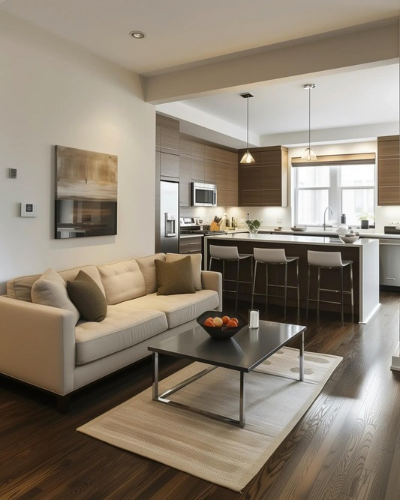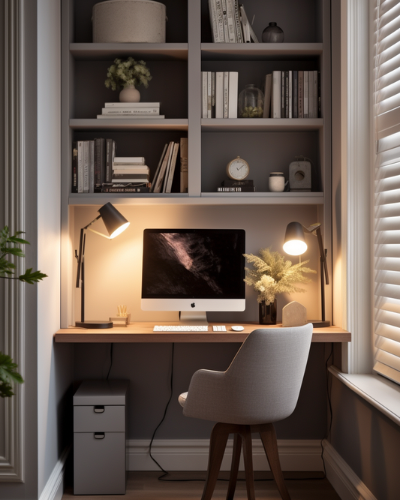Maximizing Space: Small Apartment Interior Design Tips and Tricks

Living in a small apartment doesn’t mean sacrificing style or comfort. With the right interior design strategies, you can make the most of every square inch, creating a functional and visually appealing space that feels spacious and inviting. In this blog, we’ll explore a variety of tips and tricks for maximizing space in small apartments, from clever storage solutions to strategic furniture placement. In a small apartment, every piece of furniture needs to earn its keep. Opt for multi-functional pieces that serve multiple purposes, such as a sofa bed for hosting guests or a coffee table with built-in storage. Look for furniture with hidden compartments or foldable features that can be easily tucked away when not in use, maximizing space and minimizing clutter. When floor space is limited, don’t forget about the vertical dimension. Install shelves or wall-mounted storage units to take advantage of vertical space and free up valuable floor space. Use floating shelves to display decorative items or store books and accessories, and consider installing hooks or racks for hanging pots, pans, and other kitchen essentials. Light colors have the power to make a small space feel larger and airier. Choose a neutral color palette for walls, floors, and furniture to create a sense of openness and continuity throughout the apartment. Soft shades of white, beige, and pastels reflect light and bounce it around the room, giving the illusion of more space. Natural light can work wonders in a small apartment, making it feel brighter, bigger, and more inviting. Keep window treatments light and sheer to allow plenty of sunlight to filter into the space and avoid blocking windows with heavy curtains or furniture. If privacy is a concern, consider installing translucent blinds or frosted glass window films that let in light while still providing privacy. Effective storage is key to maximizing space in a small apartment. Invest in furniture with built-in storage, such as ottomans with hidden compartments or beds with drawers underneath. Use baskets, bins, and organizers to corral clutter and keep surfaces tidy, and be ruthless about purging items you no longer need or use. Even in a small apartment, it’s possible to create distinct zones for different activities. Use area rugs, furniture arrangement, or room dividers to delineate separate areas for living, dining, sleeping, and working. By visually separating the space into functional zones, you can make the apartment feel larger and more organized. In a small kitchen, vertical storage is essential for maximizing space. Install shelves or racks on the walls to store pots, pans, and utensils, and use hooks or magnetic strips to hang knives and other tools. Consider investing in stackable or nesting cookware to save space in cabinets and drawers and make the most of under-sink storage with stackable bins or organizers. Living in a small apartment may present its challenges, but with the right interior design strategies, you can create a space that’s stylish, functional, and comfortable to live in. By embracing multi-functional furniture, utilizing vertical space, opting for light colors, maximizing natural light, streamlining storage, creating zones, and thinking vertically in the kitchen, you can make the most of every square inch and transform your small apartment into a cozy and inviting home. Recent posts
Enlightening Your Space: The Vital Role of Lighting in Interior Design

In the realm of interior design, lighting often takes center stage as a critical element that can transform a space from ordinary to extraordinary. Beyond merely illuminating rooms, lighting plays a multifaceted role in setting the ambiance, highlighting architectural features, and enhancing functionality. In this blog, we’ll delve into the importance of lighting in interior design and explore how strategic lighting choices can elevate the aesthetics and functionality of any space. Setting the Mood: Lighting has a profound impact on the mood and atmosphere of a room. The intensity, color temperature, and distribution of light can evoke various emotions and create different ambiance. For instance, soft, warm lighting can imbue a space with a cozy and intimate feel, perfect for living rooms or bedrooms. In contrast, bright, cool lighting can energize a workspace or kitchen, fostering productivity and alertness. By carefully selecting lighting fixtures and controlling light levels, interior designers can tailor the ambiance of a room to suit its intended purpose and enhance the overall experience of its occupants. Highlighting Architectural Features: Strategic lighting can accentuate the architectural features of a space, adding depth, dimension, and visual interest. Whether it’s highlighting a dramatic vaulted ceiling, showcasing intricate molding, or drawing attention to a striking piece of artwork, lighting can serve as a powerful tool for architectural enhancement. By casting light on focal points and architectural details, designers can create a sense of drama and sophistication, transforming ordinary spaces into extraordinary works of art. Enhancing Functionality: In addition to aesthetics, lighting also plays a crucial role in enhancing the functionality and usability of a space. Proper task lighting, such as under-cabinet lighting in kitchens or reading lamps in living rooms, ensures that essential activities can be performed safely and efficiently. Ambient lighting, such as recessed fixtures or pendant lights, provides overall illumination that allows occupants to navigate and interact comfortably within a room. By layering different types of lighting and incorporating dimmers and controls, designers can create versatile and adaptable spaces that cater to the diverse needs of their occupants throughout the day. Creating Visual Interest: Lighting can also serve as a design element, adding visual interest and focal points to a room. From statement chandeliers and pendant lights to sculptural floor lamps and sconces, lighting fixtures come in a variety of shapes, sizes, and styles that can complement any design aesthetic. By incorporating unique and eye-catching lighting fixtures, designers can infuse personality and character into a space, making it truly one-of-a-kind. Additionally, the interplay of light and shadow created by carefully placed fixtures can add depth and texture to surfaces, enriching the visual experience and adding dimension to the overall design scheme. Maximizing Space Perception: Strategic lighting can also influence the perception of space, making rooms appear larger, smaller, taller, or cozier depending on the desired effect. By directing light towards walls or ceilings, designers can visually expand the boundaries of a room and create an illusion of openness and airiness. Conversely, focusing light downwards or using low-level lighting can create a sense of intimacy and enclosure, perfect for creating cozy nooks or intimate seating areas. By manipulating light levels and angles, designers can manipulate the perception of space to enhance comfort and functionality while optimizing the overall design aesthetic. In conclusion, lighting is a fundamental element of interior design that transcends mere functionality to become a powerful tool for enhancing aesthetics, setting mood, highlighting architectural features, and improving functionality. From creating ambiance and visual interest to maximizing space perception and usability, strategic lighting choices can elevate the aesthetics and functionality of any space, transforming it into a truly exceptional environment. As such, investing in thoughtful lighting design is essential for creating spaces that not only look beautiful but also feel comfortable, inviting, and inspiring to inhabit. Recent posts
10 Timeless Interior Design Trends That Never Go Out of Style

Interior design trends come and go, but some timeless styles endure the test of time, transcending fleeting fads and remaining relevant year after year. Whether you’re renovating your home or simply looking to refresh your space, incorporating timeless design elements can create a timeless and elegant interior that will never go out of style. In this blog, we’ll explore 10 timeless interior design trends that are sure to stand the test of time. In conclusion, timeless interior design trends provide a solid foundation for creating a stylish and enduring home that stands the test of time. By incorporating elements such as neutral color palettes, classic furniture silhouettes, natural materials, and personalized touches, you can create a timeless and elegant interior that reflects your personality and enhances your quality of life for years to come. Recent posts
Small Space, Big Style: Creative Interior Design Ideas for Compact Homes

In today’s fast-paced urban environments, living spaces are becoming increasingly compact. However, having a smaller home doesn’t mean sacrificing style or functionality. With the right interior design strategies, even the tiniest of spaces can exude charm and personality. Let’s explore some creative ideas to maximize the potential of compact homes and create a stylish oasis. In small spaces, every square inch counts. Choose furniture pieces that serve multiple purposes, such as a sofa bed or a coffee table with built-in storage. Opt for modular furniture that can be rearranged to adapt to different needs, allowing flexibility in your layout. When floor space is limited, look up! Vertical storage solutions like tall shelves or wall-mounted cabinets help maximize storage without encroaching on precious floor area. Additionally, hanging plants or artwork can draw the eye upward, making the room feel more spacious. Light colors reflect natural light, making a space feel brighter and more open. Choose pale hues for walls, floors, and furniture to create an airy atmosphere. Mirrors are also invaluable in small spaces, as they can visually expand the room by reflecting light and creating the illusion of depth. Less is often more in compact homes. Embrace a minimalist aesthetic by decluttering and focusing on essential pieces. Choose streamlined furniture with clean lines and avoid overcrowding the space with unnecessary decorations. This approach creates a sense of serenity and openness. Even in a small space, it’s essential to delineate different areas for living, dining, and sleeping. Use area rugs, furniture placement, or room dividers to define each zone while maintaining a cohesive overall design. This division helps maximize functionality and organization. Effective storage is key to maintaining a clutter-free environment in compact homes. Explore innovative storage solutions like under-bed drawers, built-in cabinets, or hidden storage compartments. Every nook and cranny can be utilized to keep belongings neatly stowed away. Proper lighting can transform the feel of a small space. Incorporate a mix of ambient, task, and accent lighting to create layers of illumination. Consider installing adjustable fixtures or dimmer switches to customize the lighting according to different activities and moods. While keeping the overall palette light and neutral, don’t shy away from incorporating textures and patterns to add visual interest. Textured textiles like wool throws or velvet cushions can introduce warmth and coziness, while subtle patterns can lend depth to the design without overwhelming the space. If your compact home has access to outdoor areas like a balcony or terrace, make the most of it! Create an outdoor extension of your indoor living space with weather-resistant furniture, potted plants, and cozy seating areas. This expansion of living space adds versatility and enhances overall enjoyment of your home. Finally, inject your personality into the space with carefully curated accessories and décor items. Display cherished mementos, artwork, or collections that reflect your interests and style. However, be mindful not to overcrowd surfaces, as clutter can quickly diminish the sense of spaciousness. In conclusion, small spaces offer unique design challenges but also incredible opportunities for creativity and innovation. By implementing these creative interior design ideas, compact homes can become stylish and functional retreats that maximize every inch of space. Remember, it’s not about the size of the home but the style and comfort it brings to its inhabitants. Recent posts
Harnessing the Power of Color Psychology in Interior Design for the Perfect Ambiance

In the world of interior design, color holds immense power. It can influence our emotions, perceptions, and behaviors, making it a crucial element in creating the perfect ambiance within a space. By understanding the principles of color psychology and how different hues can evoke specific feelings and moods, designers can transform any room into a harmonious and inviting environment. In this blog, we’ll explore the art of using color psychology in interior design to create the perfect ambiance. Understanding Color Psychology: Color psychology is the study of how colors affect human behavior and emotions. Different colors have been shown to elicit specific emotional responses, ranging from feelings of calm and serenity to excitement and passion. By strategically incorporating colors into interior design, designers can evoke desired emotions and create atmospheres that enhance the functionality and mood of a space. Warm Colors for Comfort and Energy: Warm colors such as reds, oranges, and yellows are known for their energizing and stimulating properties. These hues can create a sense of warmth and coziness, making them perfect for spaces where socialization and activity are encouraged, such as living rooms and dining areas. Red, in particular, is associated with passion and excitement, while orange exudes energy and enthusiasm. Yellow is known to promote happiness and optimism, making it an excellent choice for kitchens and sunrooms. Cool Colors for Calm and Relaxation: On the other hand, cool colors like blues, greens, and purples are renowned for their calming and soothing effects. These hues are ideal for spaces where relaxation and tranquility are desired, such as bedrooms, bathrooms, and meditation rooms. Blue is often associated with serenity and peace, while green evokes feelings of harmony and balance. Purple, with its regal and luxurious undertones, can create a sense of elegance and sophistication. Neutral Colors for Versatility and Sophistication: Neutral colors such as whites, grays, and browns serve as the foundation of interior design, providing a versatile backdrop that complements any color scheme. These hues are prized for their timeless appeal and ability to create a sense of balance and harmony within a space. White symbolizes purity and simplicity, while gray exudes sophistication and elegance. Brown, with its earthy and grounding qualities, adds warmth and depth to any room. Creating Contrast for Visual Interest: Incorporating contrast into a color scheme can add visual interest and drama to a space. Contrast can be achieved by pairing complementary colors (those opposite each other on the color wheel), such as blue and orange or red and green. Alternatively, designers can use contrasting tones within the same color family, such as light and dark shades of blue or gray. By playing with contrast, designers can create dynamic and visually engaging interiors that capture attention and evoke emotion. Balancing Bold and Subtle Accents: While bold colors can make a statement and infuse a space with personality, they should be used sparingly to avoid overwhelming the senses. Instead, designers can incorporate bold accents through furnishings, accessories, and artwork, adding pops of color that draw the eye and enliven the space. Subtle accents, such as soft pastels or muted tones, can be used to create visual interest without overpowering the overall color scheme. By striking a balance between bold and subtle accents, designers can create cohesive and visually pleasing interiors. The Role of Lighting in Color Perception: It’s important to consider the role of lighting in color perception when designing a space. Natural light can enhance the vibrancy of colors and create a sense of warmth and openness, while artificial lighting can alter the way colors are perceived. Warm lighting, such as incandescent or halogen bulbs, can enhance the warmth of warm-toned colors like reds and oranges, while cool lighting, such as fluorescent or LED bulbs, can accentuate the coolness of cool-toned colors like blues and greens. In conclusion, color psychology is a powerful tool that can be used to create the perfect ambiance in interior design. By understanding how different colors influence human emotions and behaviors, designers can strategically incorporate hues into a space to evoke specific feelings and moods. Whether it’s warm colors for comfort and energy, cool colors for calm and relaxation, or neutral colors for versatility and sophistication, the possibilities are endless. By harnessing the power of color psychology, designers can transform any room into a harmonious and inviting environment that resonates with its occupants on a deep emotional level. Recent posts
